#Interior Focal points
Explore tagged Tumblr posts
Text
The Need for Focal Points in Interior Design
Interior focal points are essentially design techniques for providing visual structure. Basically, they guide the eye and creating a sense of balance within a space. Without a clear focal point, a room can feel disorganized or lacking in cohesion. We simply have to strategically incorporate statement pieces—such as an accent wall, a bold piece of furniture, or striking lighting. These elevate the professionalism of interior designers by anchoring the space, drawing attention to key elements while enhancing the overall interior aesthetic. In fact, focal points help establish hierarchy in design. How? They ensure that spaces feel intentional rather than overwhelming or cluttered.
Functionality of Focal Points
Beyond aesthetics, focal points contribute to the functionality of a space by defining areas and improving spatial flow. In open-plan layouts, for example, a well-placed focal element can create subtle separations between living room, dining, and work areas. Additionally, focal points evoke emotion and set the mood of a space, which can be through a calming artwork in a bedroom or a dramatic chandelier in a lobby.
So, integrating thoughtfully designed focal points, interiors become more engaging, practical, and visually compelling, elevating the overall experience of a space.
Read more from an Interior Design Company in Dubai
#interior design dubai#fit out Dubai#Focal Points#Interior Focal points#Fit Out Focal points#focal points functionality#living room design#bedroom design#office furniture Dubai#statement furniture#interior design contractor#interior design Dubai#villa interior design#office design#interior depth#interior aesthetics#interior luxury#interior design company#create focal points#design techniques#modern interior design#office furniture#office fit out#modern office design#furniture#visual interior design#art of interior design#hierarchy in design#visual structure
0 notes
Text
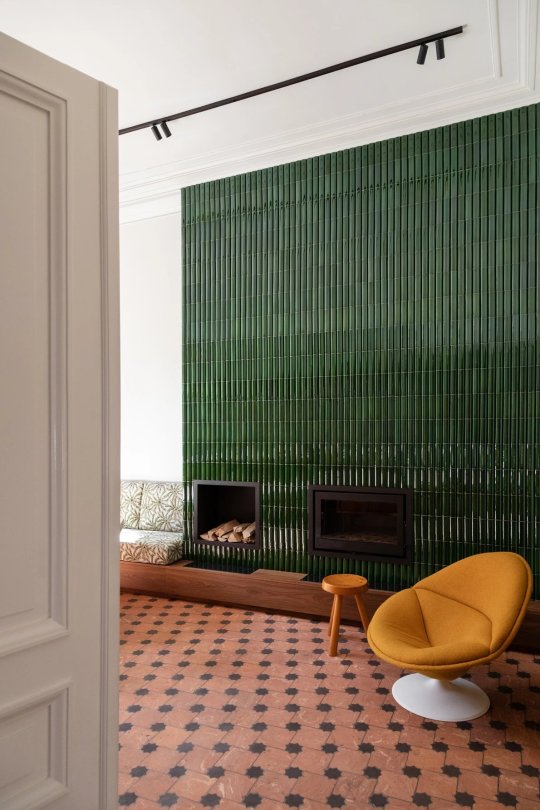
The green tile fireplace is the focal point in this space.
#green#tile fireplace#tiles#fireplace#modern fireplace#fireplace designs#wall feature#focal point#yellow chairs#may#spring#toya's tales#style#toyastales#toyas tales#home decor#interior design#modernist#modern home#modern design#home decorating#design#decoration#decor#decorate#home improvement#home inspo#home interior#interiors#interior
124 notes
·
View notes
Text

@thenordroom
#kitchen#vaulted ceiling#flying buttresses#green cabinets#range hood focal point#butcher block#pleated pendants#subway tiles#interior design
103 notes
·
View notes
Text
Illuminate Your Space with Las Sola Lights
Transform your living room into a radiant haven with exquisite lighting fixtures. Each piece is designed not only to brighten your space but also to enhance your decor. With a variety of styles and designs, these lights can easily become the focal point of your home, creating a warm and inviting atmosphere. Embrace the beauty of light and let your living room shine with elegance and charm!
0 notes
Text
Creating a Stunning Focal Point in a Bedroom Design
A focal point is the centerpiece of a bedroom that immediately draws attention and sets the tone for the entire space. The most common way to establish a focal point is by designing a feature wall, often positioned behind the bed. This can be achieved using bold paint colors, textured wallpaper, wooden slats, or even an upholstered headboard, adding depth and character to the room. A well-designed feature wall serves as a striking backdrop while complementing the overall aesthetic.
Lighting plays a crucial role in enhancing the focal point. Pendant lights, wall sconces, or LED strip lighting can be used to highlight textures and architectural details, creating a warm and inviting ambiance. A chandelier or statement ceiling light can also act as an additional focal element, drawing the eye upward and adding elegance to the space. Proper lighting ensures that the focal area remains visually appealing, even at night.

Furniture and décor choices should also contribute to reinforcing the focal point. A statement bed frame, large artwork, or an oversized mirror can create visual impact while maintaining a balanced layout. Incorporating textured bedding, accent pillows, and stylish nightstands further enhances the appeal without overwhelming the space. The key is to select pieces that work harmoniously with the main focal feature, ensuring a cohesive look.
Lastly, color coordination and symmetry help in refining the overall design. A well-thought-out color palette that complements the focal wall ensures harmony within the room. Symmetrically placed elements, such as matching bedside tables or lamps, can add structure and balance. By carefully curating design elements, a thoughtfully designed focal point can transform a bedroom into a visually stunning and relaxing retreat.
#interior design#bedroom design#feature wall#focal point#furniture#color palettes#accent walls#residential fit out duabi#interior design dubai#large artwork#bedroom artwork#fit out#visual impact#bold colors#symmetry
1 note
·
View note
Text
Home Style Guide: Your Source for Interior Design Inspiration

Designing your home in a way that not only reflects your personality but also provides convenience and order is definitely an exciting and evolving process. A home that has a measurable liveliness factor is the one that is not only filled with furniture but is carefully arranged so it becomes the embodied narrative of your life. Where to begin? These fundamentals are crucial to your sensitive interior designs, comprising both perception and application to your transforming endeavors.
Defining Your Style:
Before diving into paint swatches and furniture catalogs, take time to define your personal style. Browse magazines, online platforms like Pinterest and Instagram, and even visit show homes to gather inspiration. Ask yourself:
What colors resonate with me?
What kind of atmosphere do I want to create (e.g., cozy, modern, minimalist, eclectic)?
What are my favorite design elements (e.g., natural materials, bold patterns, vintage finds)?
You must confirm your style, for this will be a cornerstone for all of your design decisions, which will need to be very coherent and in harmony if dry lines are seen to be aesthetically fit within your home.
Key Elements of Interior Design:
A few things beyond this interaction contribute to forming a successful interior design. Knowing these principles will help you make informed decisions:
Color: The color has been a means of expression. Blue stands for a feeling of peace and comfort. They may even promote the sleeping of the babies. Balancing the presence of blue colors.
Space: Understanding room circulation and the way furniture is placed in space are two primary aspects required to create a functional and cozy environment.
Light:Natural and artificial light have a significant effect on how a space is perceived. Utilize natural light to the maximum extent possible and bring in various types of artificial lighting to give the room a sense of depth and warmth.
Texture and Pattern: Texture and pattern are added to the wall with the help of fabrics, rugs, and decorative accessories that give good experience and make space more enlarging.
Furniture and Accessories: Look for furniture that is useful to you. Decoration is the last detail that is connected to your living space. Ideally, they should have a story of their own.
Tips for Creating a Cohesive Design:
Start with a Focal Point:The core of a room will be highlighted by every space, either a fireplace, the big window or the main piece of the furniture.
Create a Mood Board: Collect fabric swatches, paint chips and images that inspire you into a mood board. This will also help give you a picture of what your design will look like as well as keep things consistent.
Consider Scale and Proportion: Select furniture and accessories that are proportionately scaled to the size of the room.
Don't Be Afraid to Mix and Match: What is great is mixing styles and epochs. Just make sure to do so considered and intentionally.”
Edit and Declutter: Having a clutter-free space means you are ensured a well-designed space. Regularly edit your possessions and declutter to have a feeling of order and tranquility.
Finding Your Inspiration:
Inspiration is all around us. Here are some tools and resources to inspire your creativity:
Online Platforms: Pinterest, Instagram and Houzz are iconic resources for design inspiration.
Magazines: Interior design magazines provide curated inspiration and expert advice.
Show Homes: Visiting show homes allows you to see design trends in action.
Travel: Exploring different cultures and architectural styles can spark new ideas.
Making it Your Own:
But at the end of the day, the No. 1 thing about interior design is designing a space you love. So have fun, take risks, and customize your home to fit your taste!
#Interior Decorating#Home Styling#Home Renovation#Interior Design Tips#Design Inspiration#Mood Board#Focal Point#Color Palette#Space Planning#Lighting Design#Texture and Pattern#Furniture Selection#Accessories#Decluttering#Cohesive Design#Modern Design#Minimalist Design#Eclectic Design#Cozy Design#Natural Materials#Vintage Finds
1 note
·
View note
Photo

Luxury Staircase Wallpaper ✨
Transform your space into a realm of elegance with our stunning Luxury Staircase Wallpaper! Whether you're looking to spruce up your home or add a touch of sophistication to your office, this wallpaper is the perfect choice. 🏡💼
Imagine stepping into a room adorned with this exquisite design, where every glance feels like a walk through a luxurious estate. The intricate details and rich colors will elevate any wall, making it a focal point that draws admiration from all who enter. 🌈
Why settle for ordinary when you can have extraordinary? Our Luxury Staircase Wallpaper is crafted with care, ensuring that it not only looks fantastic but also lasts for years to come. Perfect for those who appreciate the finer things in life!
Ready to transform your space? You can easily enhance your decor with this wallpaper. Just click on the link below to bring a touch of luxury into your life: Elevate Your Decor
Let your walls tell a story of elegance and style. Happy decorating! 🎨
#luxury#elegance#wallpaper#interior design#home decor#staircase#sophistication#modern#artistic#rich colors#decorative#focal point#high-end#stylish#residential#office#renovation#creative#design inspiration#wall art
1 note
·
View note
Text
Embrace the Glow: Modern Neon Home Interior Design

View On WordPress
#acrylic#backyard#balcony#bathroom#bedroom#color schemes#complementary colors#cool tones#dimming controls#focal points#functional lighting#glass#high quality#home decor#home decoration#impactful design#interior design#interior design catalog#metallic accents#minimalist furniture#modern interior design#modern neon home interior decoration#monochrome#neon light#neon lights#niche accents#statement pieces#sweet home usa interior decoration#warm hues
0 notes
Text
Significance Of Symmetry & Balance In Interior Design
Significance Of Symmetry & Balance In Interior Design - #homeimprovementreferral #InteriorDesign, #PopularPosts - https://www.homeimprovementreferral.com/significance-of-symmetry-balance-in-interior-design-2023-09/
#aspects of interior design#Balance#Focal Points#functionality#harmony#interior design#lighting#sense of balance and harmony#Symmetry
0 notes
Text
Feature Wall vs. Accent Wall: Which One Should You Choose?
When designing a living space, both feature walls and accent walls can add depth, style, and personality. However, choosing between the two depends on your design goals, room layout, and desired visual impact.
1️⃣ What is a Feature Wall?
A feature wall is a bold, eye-catching wall that acts as the main focal point of the room. It often features unique materials, textures, or colors, such as: ✔ Wooden panels for a warm, cozy look. ✔ Stone or marble for a luxurious feel. ✔ Porcelain tiles for a sleek, modern finish. ✔ Bold wallpaper with patterns or murals for artistic expression.
🔹 Best for: Creating a strong statement in the room, especially behind a TV, fireplace, or sofa.
2️⃣ What is an Accent Wall?
An accent wall is a subtle enhancement rather than the main focus. It is designed to add depth and dimension without overwhelming the space. Accent walls usually have: ✔ A different paint color (slightly darker or lighter than the rest of the room). ✔ Subtle textures, such as wainscoting or molding. ✔ Soft wallpaper with a delicate pattern.
🔹 Best for: Adding depth and contrast to the space without overpowering the overall design.
3️⃣ How to Decide?
✔ Go for a Feature Wall if: ✅ You want a bold, dramatic focal point. ✅ Your space feels plain and needs more personality. ✅ You are using high-end materials like stone, wood, or tiles to add luxury.
✔ Go for an Accent Wall if: ✅ You prefer a subtle, balanced design. ✅ You already have other strong décor elements (e.g., statement furniture or artwork). ✅ Your room is small, and a bold feature wall might feel overwhelming.
4️⃣ Can You Have Both?
Yes! A feature wall and accent walls can work together if designed with balance. For example: You can even have a fancy living room design while combining both feature and accent walls for a unique and creative scene.
Read more to understand their differences 👉
#interior design#Interior design Dubai#living room design#residential fit out#office fit out#commercial fit out#interior design elements#feature walls#accent walls#bold design elements#Home design Dubai#Interior decor#interior depth and contrast#focal point#textures#wallpaper#home office design#lifestylr#modern interior design#luxury interior design#differences feature and accent walls#bespoke interior design#paint color#room layout#wooden panels#porcelain tiles
0 notes
Text
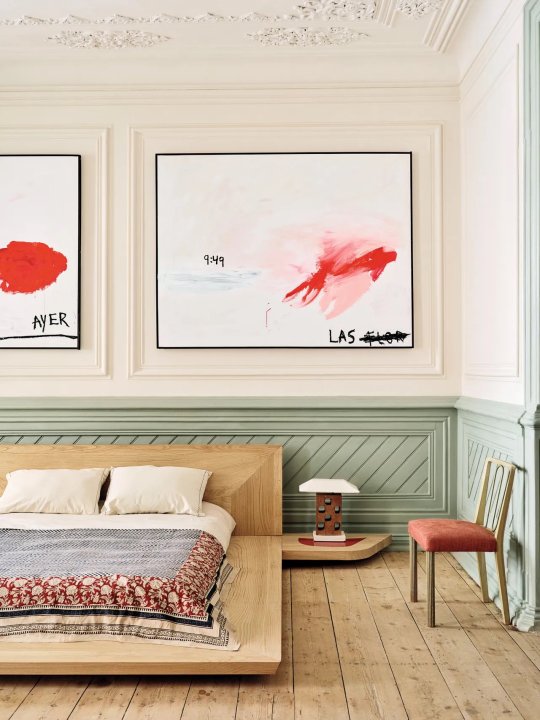
Art is the main focal point in this bedroom.
#focal point#focus#art wall#art appreciation#art aesthetic#abstract#contemporary art#wainscoting#platform beds#april#spring#toya's tales#style#toyastales#toyas tales#home decor#art#interior design#home decorating#decor#decorate#transitional bedroom#bedroom#bedroom furniture
74 notes
·
View notes
Text
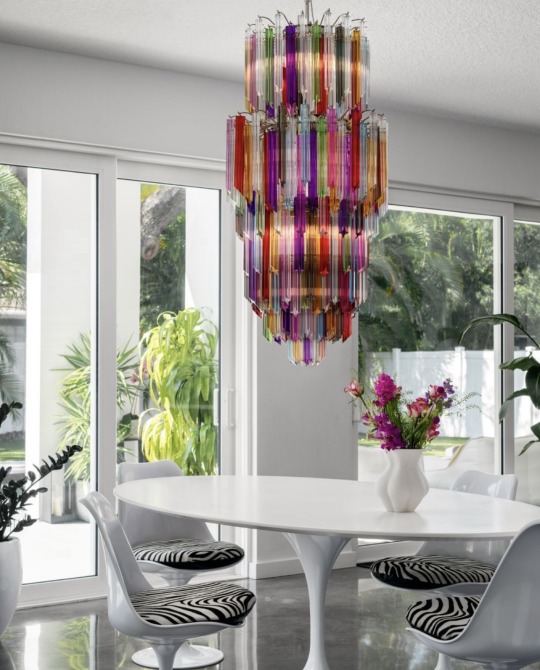
IG lisagilmoredesign
#chandelier#cascade of color#white room#pops of color#dining space#open concept#focal point#interior design
37 notes
·
View notes
Text
Andrus Laansalu talked about making Disco Elysium at EKA (Estonian Academy of Arts)

"Initially, the church wasn't a focal point. There were certain characters that needed to visit this location, and I asked, "Seriously, what do we have in our church?" The others replied, "Nothing at all. Our church is completely bare—just a wheel, really. It's quite basic."
That's when I decided to unleash my creativity in the design. For example, they chose to install a glass structure at the top of the church to create a reflective surface. It was like placing an optical clock up there. Therefore, one of the most crucial aspects of designing the church was ensuring the lighting was just right to create the desired atmosphere."


"Let me show you an example of Baroque architecture, which is rich in detail. We're also designing the interior of the church based on large cathedrals. However, the foundation you use might not yield the expected results, because the church itself doesn't require such intricate details. Sometimes, it's about simplifying the design."


"I used Articy for the initial scriptwriting of Disco Elysium. The image only represents a tiny fraction of the text and choice variables involved. This system was also the reason I eventually abandoned the project after a year of outlining the script and shifted my focus to becoming a sound designer. My mind struggled to keep up with the dynamic graphic rules, but fortunately, a more talented writer took over afterward."

"In terms of sound design, it's essential to develop different layers to bring out the charm of the church as a cohesive space. Although this represents only a small portion of the overall design, each layer actually requires a significant amount of time to compose the whole....... Whenever there's a shift or a change due to the dialogue itself, you need to adjust the background sounds. Each time you modify the details in the dialogue, I have to refine the background audio, ensuring that these elements build upon each other like an intricate layer of work."


"It's funny how many scenes involve characters getting smacked in the face. My job was to recreate those, so I locked myself in the bathroom with a recorder and hit my forehead until it turned red.
As a sound designer, I really dig those unsettling, drill-like sounds. So, I mixed in creepy lectures, metal scraping, moans, and cries of pain—because I just love that stuff! (laughs)
Players will be moving through all kinds of areas, so it's super important to make the sound transitions feel natural, trying to create a more immersive vibe in certain spaces.
With all the scenes featuring big cranes, you can hear them from far away, and I wanted to capture that eerie ringing in your ears. That's going to be a thing throughout most of the game. I've found ways to really mess with players while they're playing!"


"I've come across a lot of old objects (like phones and radios) that I needed to perfectly replicate the sounds. I started to become a bit of a hoarder, buying up different models of old phones whenever I found one to add to my collection. The sound effects I can simulate from them are really impressive."


"Some of the devices don't actually exist in real life—just a mix of architecture and tech. When I need to create sound effects, I first look for something similar that exists in our world, then I try to simulate what the sound and appearance of that thing might have been like a century ago.
Towards the end of the game, there's a character carrying a fuel canister. We needed the sound of the canister, so we dug one up from our garage—it had been sitting there since it was five! I realized this would make the sound perfect. So, it had been there for 50 years, and after 40 years, it finally found its purpose.
In some places, I needed unique sound waves, and recreating them was a real headache until one day I happened to walk by a swimming pool and stumbled upon an old wartime torpedo. You can rotate the torpedo's probe, and it slowly rises up, like a proud zombie head. The sounds it made were exactly what I needed!"

🙋How did you manage to get funding?
"Well, since we're in Estonia, you just need to know a wealthy person. You don't need five people—just two who can network, hang out together, and convince them to keep investing! (laughs) Back then, we constantly ran out of money and would tell them, 'Oops, looks like we spent it all! Can you invest a bit more?' That's how we made it through!"
🙋How did you all come together to make the game?
"Luck. It usually doesn't happen this way, and that's the key difference. It has to be. If not, you couldn't create a game of this scale - well, I mean in terms of budget. But creatively, Estonia definitely has writers and artists who can pull it off. With such a small population, there are a lot of quirky folks who are good friends. We were really lucky, though - lots of fortunate circumstances came together. It brought the right people together, allowing those talented fools to collaborate with us. They had experience but hadn't tackled projects of this magnitude before. So yeah, luck is pretty important!"
Lecture experience shared by 白兔YIYANG SUN on 小红书, reposted & translated by me with her permission.
#disco elysium#inspiration#I was so touched by the parts#50 yrs later the old fuel can was found#and the torpedo does art not harm#i need to take down notes#sobbing#you guys are a miracle
3K notes
·
View notes
Text
From Trash to Treasure - The Art of Collage Wall Décor
In the realm of interior design, the concept of recycling and repurposing has gained significant traction. One of the most exciting and creative ways to incorporate this ethos into your home décor is through collage wall art. Have you ever looked at old magazines, newspapers, and discarded paper items and wondered if there’s a way to turn them into something beautiful? Enter the world of collage…
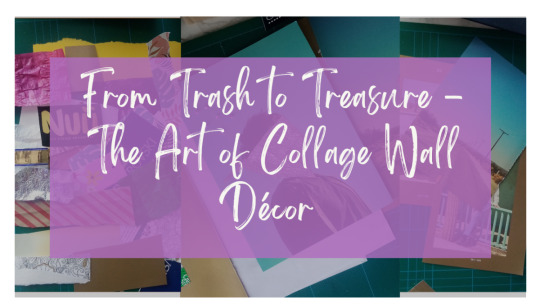
View On WordPress
#Aesthetic Home Accents#Artistic Expression#Contemporary Minimalism#Crafted Memories#Crafted Wall Decor#Creative Recycling#Creative Upcycling#Decorative Focal Points#Designing with Discarded Items#DIY Collage Art#Eco-Friendly Design#Expressive Home Art#Handmade Wall Pieces#Home Decor Inspiration#Home Interior Creativity#Interior Design Trends#Mixed Media Art#Personalized Living Spaces#Personalized Wall Art#Repurposed Materials#Sustainable Lifestyle#visual storytelling
0 notes
Text

They took a different approach to converting this 1913 bank in Negaunee, MI to a home. 3bds, 3ba, 7,750 sq ft, $499,900.
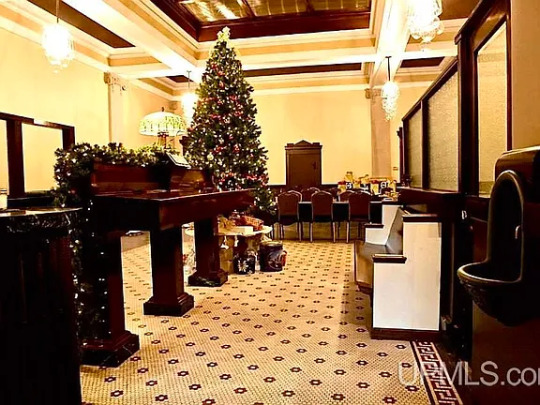
They left the main floor original- it still looks like a bank. Look at the fountain on the right.
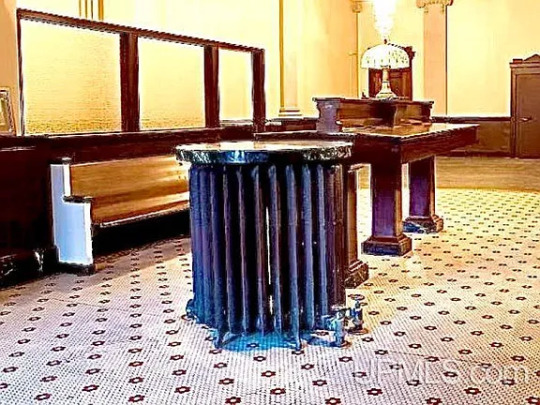
The focal point of the room is this unique round radiator.
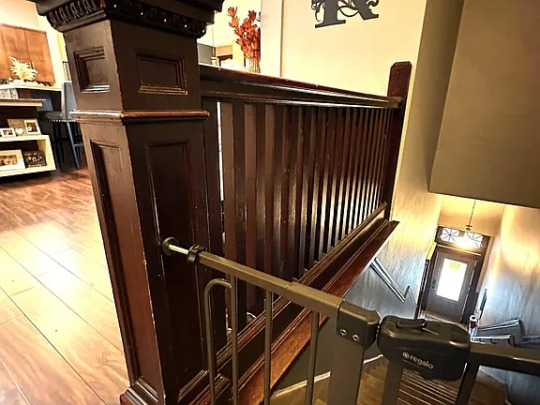
The living quarters are on the upper floor.
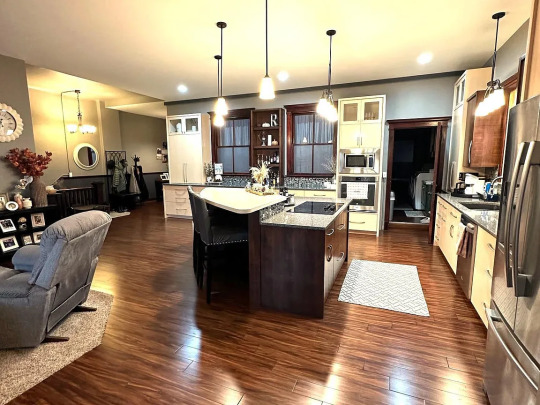
It was completely renovated, but still looks vintage.
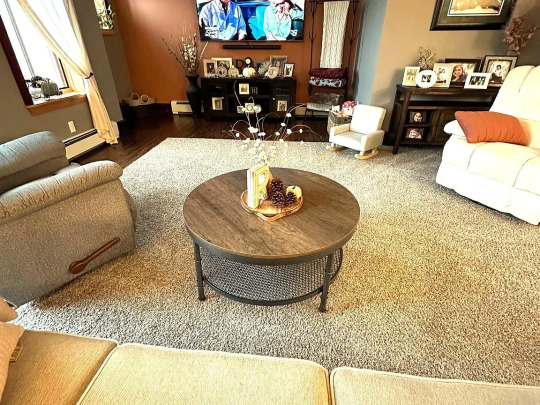
Cozy living room area.
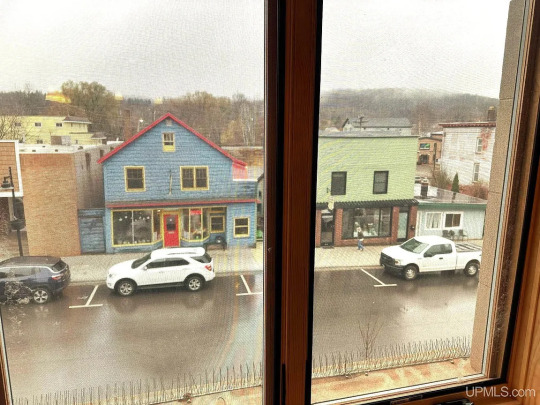
The street view from the window.
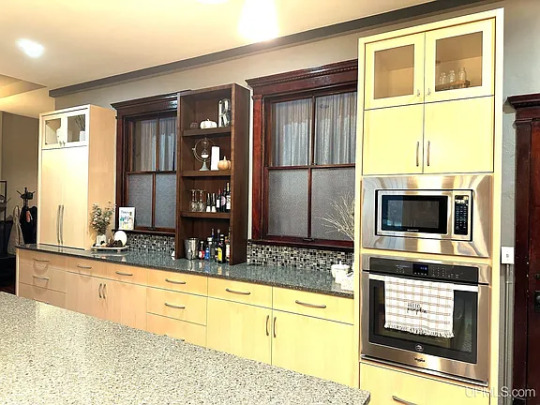
This is nice- they incorporated original windows and picked vintage looking cabinetry.
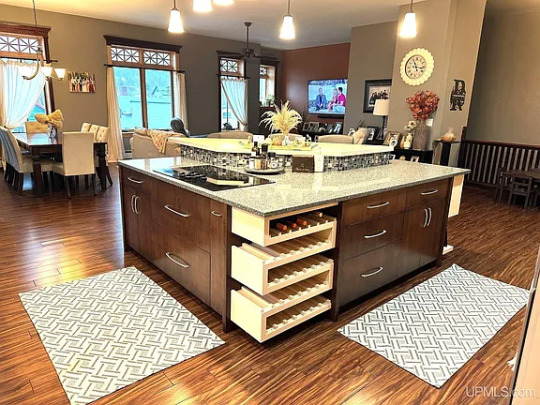
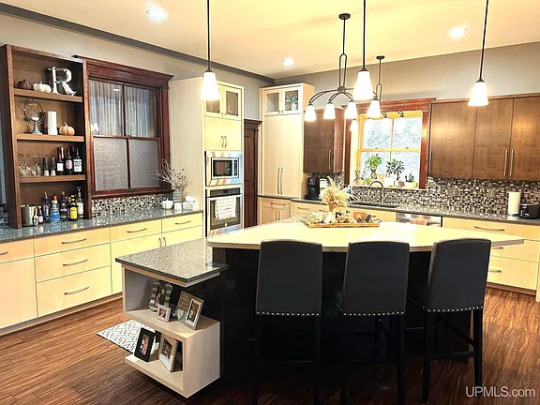
They've got a huge center island with appliances, lots of storage, wine racks, a counter for dining, and even display shelves.
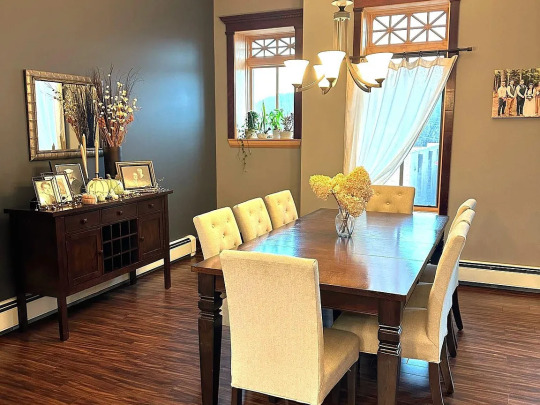
Then, here there's a very nice dining area.
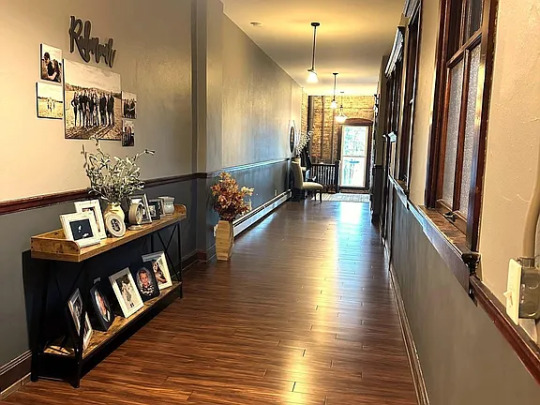
Nice wide hallway with original windows to the various offices.
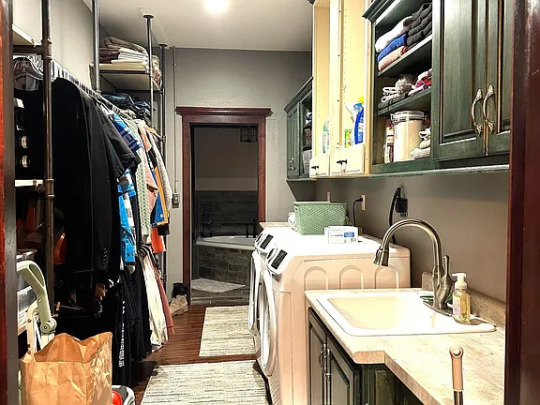
The laundry room has storage.
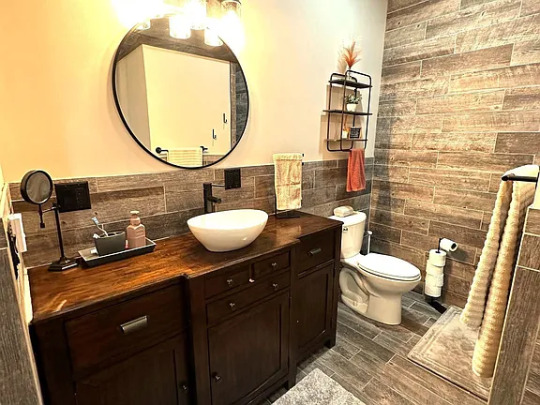
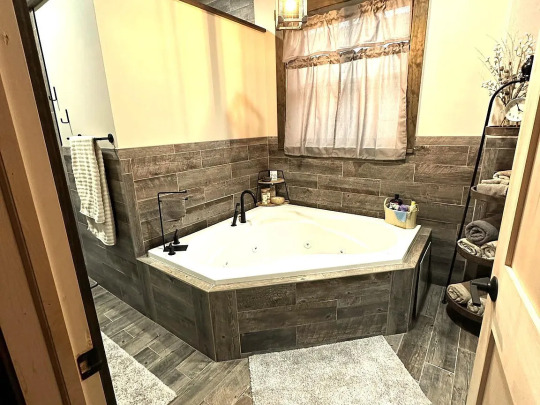
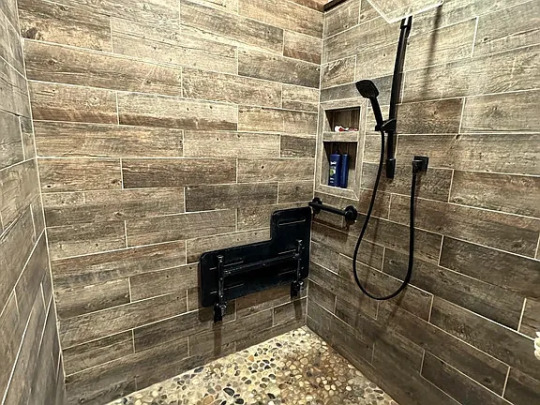
And, there's a lovely large bath back here, too.
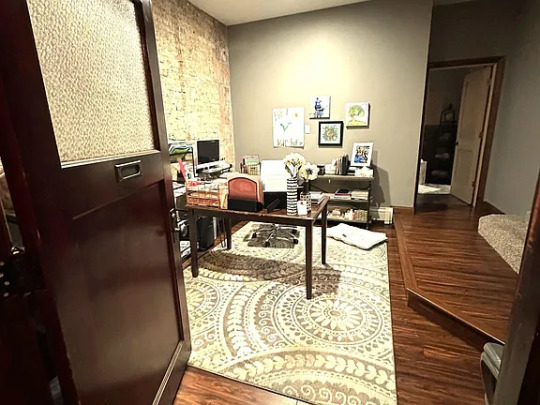
The home office is an old office with a great exposed brick wall.
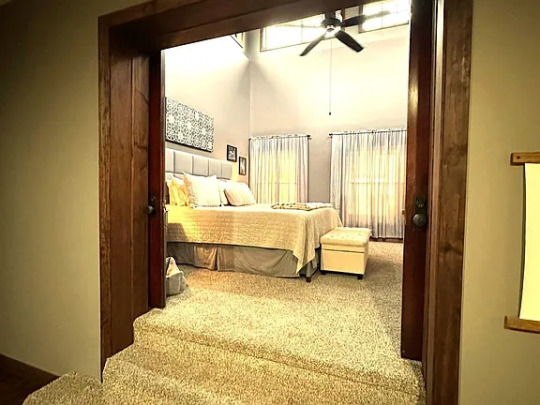
This is different- I wonder what the platform and stairs were to this room. Maybe it was the bank president's office.
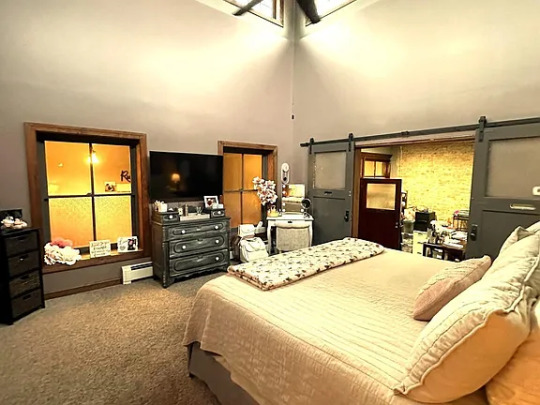
It's now a cool primary bedroom with sliding industrial doors and 2 big interior windows.
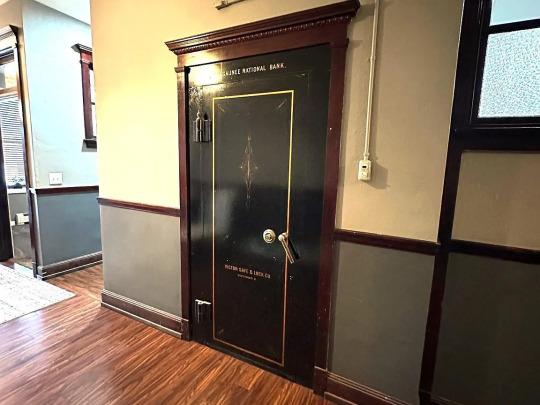
The safe is still intact.
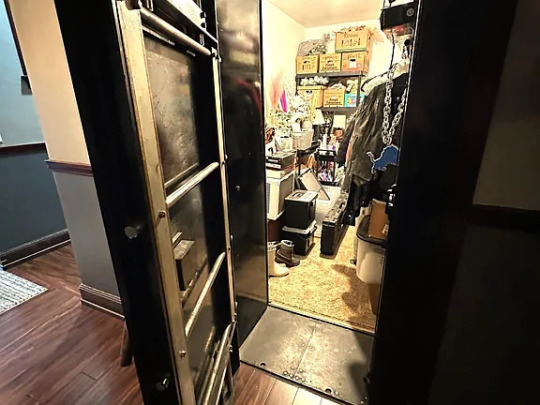
And, it's now a storage room.
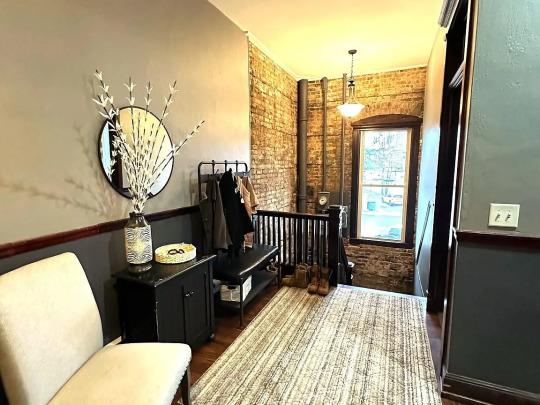
The rear stairs are lovely.
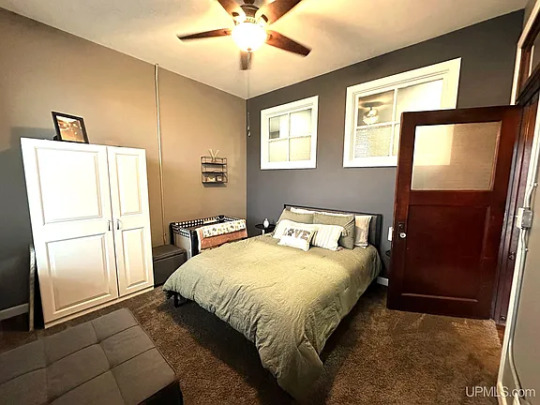
Another bedroom back here is a nice large size with an original door and windows.
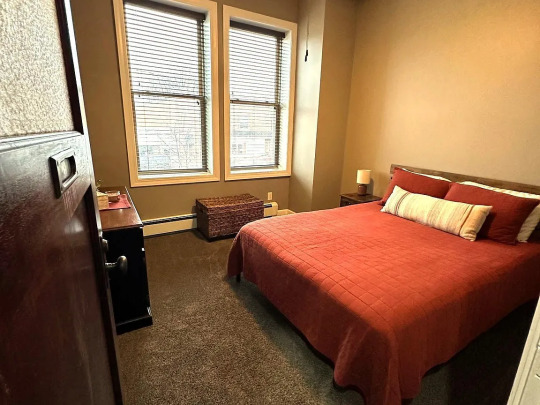
Bedroom #3 is lovely, too. Look at the little mail slot in the former office door.
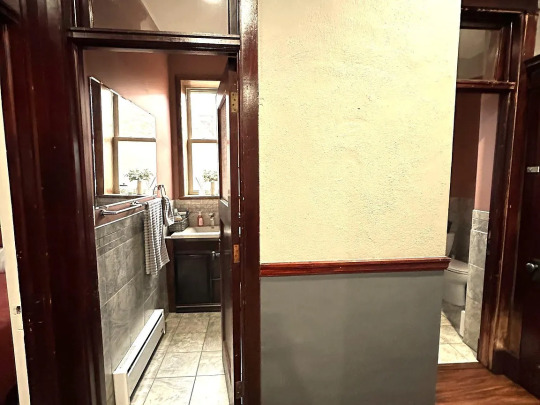
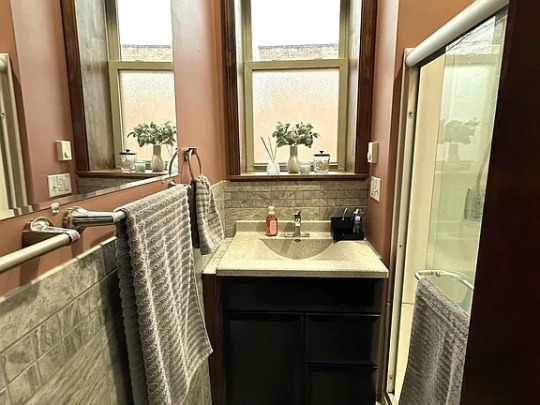
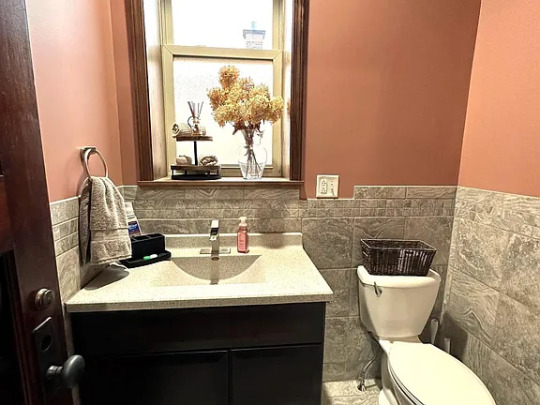
There's a shower room with a sink and a separate 1/2 bath.
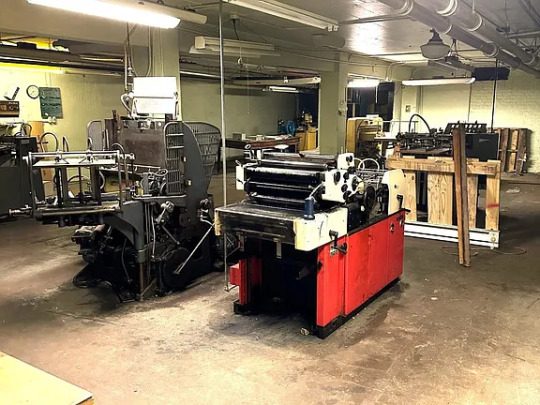
I don't know what all this equipment in the basement is. Is it from the bank?
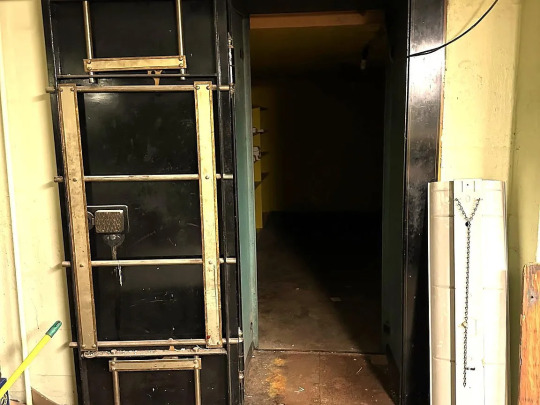
This is creepy. Is it an old elevator?
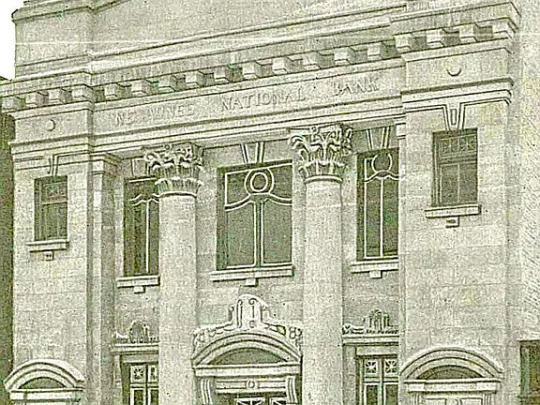
The building looks the same as it did in 1913. 8,712 sq ft lot
https://www.zillow.com/homedetails/318-Iron-St-Negaunee-MI-49866/442726043_zpid/
242 notes
·
View notes
Text
Writing Notes: Neutral Colors

Neutral Colors - muted shades that appear to lack color but often have underlying hues that change with different lighting. Examples:
beige,
taupe,
gray,
cream,
brown,
black, and
white.
Types of Neutral Colors
The basic neutral color palette comprises black, white, brown, and gray, with varying shades in between. Here is a breakdown of the various types of neutrals:
Pure neutrals: The pure neutral color palette includes black, white, brown, and gray, all of which fall under the category of pure color, which means they are fully saturated and do not have an undertone (underlying color). By mixing different pure neutrals and primary colors, you can influence the resulting color’s saturation and vibrancy.
Near-neutrals: Mixing a primary color with a pure neutral color creates a near-neutral. For instance, to make the near-neutral color tan, mix the primary color yellow with the pure neutral brown. Near-neutral colors have lower saturation than pure neutral colors. Similarly, pairing a neutral color with a bright hue increases the vibrancy of the hue, attracting the eye to that particular spot of color.
Warm and cool neutrals: Mixing different pure neutral colors with primary colors creates either warm neutrals or cool neutrals. Warm neutrals have yellow, orange, or pink undertones, such as beige, tan, and gold, while cool neutrals have blue, purple, or green undertones, such as gray, taupe, and ivory.
Advantages of Decorating With a Neutral Color Palette
Interior designers use neutral color palettes to create different visual effects, playing with focal points, depth, saturation, and highlights to enhance a living space. Here are some of the advantages of decorating with a neutral color palette:
You can build off neutral tones. When you paint or decorate a space with a neutral color, you can build off that tone, incorporating accent colors or bold patterns. Overusing bold colors makes the room overwhelming and distracting for the eye. Neutral colors help balance a room so that you can add different accessories and patterns.
Neutrals pair well with a range of colors. Through different seasons, your style and preferences may change. Changing your home décor with a new pattern piece or set of curtains is easy when your room has a neutral color palette because it's versatile and pairs well with different color schemes and design elements. Simply adding new throw pillows to your couch can change the look of your living room and match your new style.
Neutrals can have a calming effect. While bright, bold colors are loud and vibrant, neutral paint colors are calming and gentle on the eye. With little saturation, neutral colors seamlessly flow from one color into the next. Most neutral palettes also reflect naturally occurring colors, shaping a living area into a relaxing, nature-based space.
You can use any decorating style. Different interior design styles incorporate neutral colors, from modernism to rustic to art deco. As a natural foundation for any background, neutral colors enhance different tones and patterns. For instance, neutral shades balance geometric patterns in an art deco room, whereas darker neutrals create a streamlined, sleek effect in a modern room.
Tips for Decorating with Neutral Colors
When working with a neutral color scheme, find subtle DIY ways to add texture and color ideas for versatility.
Use different tints: Tonal color palettes add highlights and accents to a neutral color palette, making areas of a room pop. Incorporate different tints and neutrals to create a more lively and engaging space. Consider pairing sage green with a predominantly gray and white room to add a tint of color—a pop of pink pairs nicely with warmer neutrals, such as gold or beige.
Consider the lighting: A room’s lighting influences how your eyes read a color. Artificial lighting tends to have a yellow hue, so it intensifies warmer neutrals. Consider factors such as the season, time of day, the sun’s position, and the room’s location when choosing your color schemes. For example, natural light from the north creates a blue tint, making neutral colors appear darker and less saturated, while eastern or western light creates a warmer hue. White paint comes in various shades; they also appear differently depending on the natural lighting.
Add color with accessories: Pairing neutral walls with neutrally colored large furniture pieces can create a calming effect, but that doesn’t mean you must sacrifice color. Instead, incorporate color in the different accessories in the room, such as throw pillows, artwork, or curtains. Choosing accessories with color makes it easier to change the room’s style and décor to match different seasons.
Choose the right color: Different near-neutral and pure neutral colors have varying effects on a room. Dark, cool colors create a cozy feel within a room, while lighter neutrals make a room appear larger. Choose a room color that aligns with the design and feel you want for the space.
While neutral colors are not on the color wheel, they complement primary and secondary colors.
You can combine primary colors—like red, white, and blue—to make a range of other colors.
Secondary colors are the result of mixing two primary colors, like green (yellow plus blue), orange (yellow plus red), and purple (red plus blue).
Neutral colors can be complex in tone, as mixing different colors creates unique shades.
For example, greige is a mix of light gray and beige, with yellow hues in natural light and gray in fluorescent lighting. (Natural light refers to lighting generated from a natural source like the sun.)
Source ⚜ More: Notes & References ⚜ Writing Resources PDFs
#colors#colour#writing reference#writeblr#neutral#literature#dark academia#writers on tumblr#spilled ink#creative writing#writing prompt#light academia#writing inspiration#writing ideas#worldbuilding#writing resources
87 notes
·
View notes